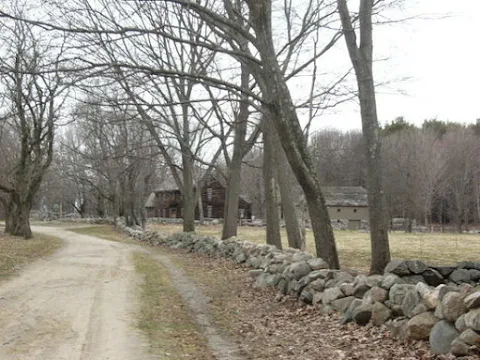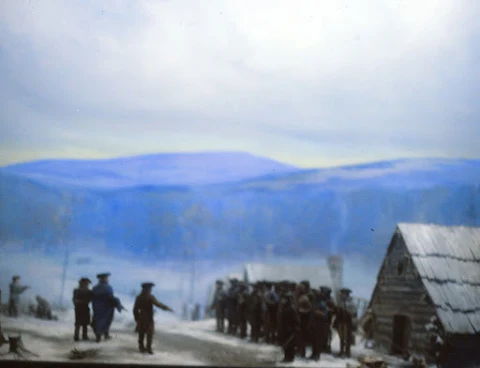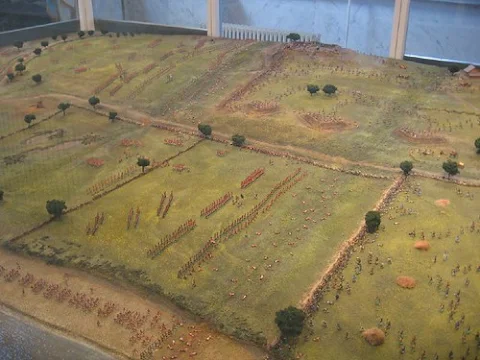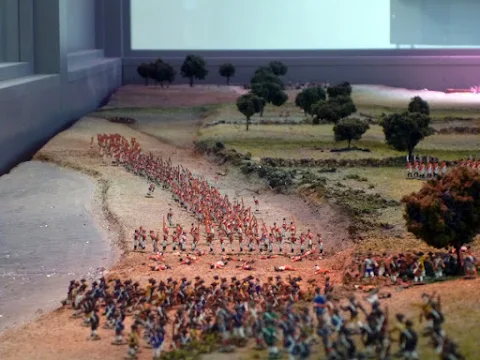Saturday, May 2, 2020
Stuart Asquith and the War of 1812: A review of two books
I was asked recently by a friend about these two books. How different are they and are they worth getting? Another fruend asked me if they are just the same thing with different covers or if they duplicate the same materials. To answer those questions here is a shirt review of my opinion about these books. Both of which I own.
The War of 1812: A Campaign Guide to the War with America 1812-1815
Opening this book at the On Military Matters stand at Cold Wars a few years ago I was delighted right away. It is a book a wargamer would write. One who loved the period. Well written, lots of illustrations and bunches of helpful details. Just the stuff you need if starting the period or are an old hand who needs inspiration. I bought it right away.
As far as the content of the book it can be described as being in three parts. The first third of the book is devoted to a general history of the war per year (from 1812 to 1815). There is also a chapter devoted to the naval aspects of the war. The text is short, clear, and very understandable. most of the illustrations in this section are old prints and maps; many out of Benjamin Lossing's Field Book of The War of 1812.
The next section is devoted to the armies; British, Canadian United States and Indians. This section describes the composition of armies and the uniforms worn. Many are of obscure small units. Great details here and very handy. A small part is devoted to the “Indians” (Native Americans), about their involvement in the war and the main actions involving them.
The illustrations here are worth The price of the book. There are a number of outstanding uniform plates by Bob Marrion. There are also numerous photographs of reenactors here. It is interesting to see the uniforms and how they look on real people rather then miniatures
The third and last part is wargaming the War of 1812. How to integrate the tactical particularities of this unusual war into a set of rules. The quality and types of troops, what figures are available and where to get them. All scales are mentioned. numerous pictures of wargamer figures illustrate this section. The figures are usually 25mm Wargame Foundry or 54mm figures. Please keep in mind the wonderful line of figures from Knuckleduster are not listed as they were not yet created when this book was written.
It is also an expensive book. Because it is hardback and filled with colorful illustrations. But you get a book that will last and you will return to time and again.
Scenarios for the War of 1812-1815
This scenario booklet has been written with the wargamer in mind. If you are looking for a quick guide to some of the important actions and how to Guggenheim on your table top here is your guide.
After a capsule summary off the war the author lays out twelve battles forgoing fight. The battle listed are:
Queenston Heights, 13th October 1812
Raisin River, 18th/22nd January 1813
The Assault on York, 27th April 1813
Sacket's Harbor, 29th May 1813
Beaver Dams, 24th June 1813
Thames River, 5th October 1813
Chateaugay, 25th October 1813
Crysler's Farm, 11th November 1813
Chippawa, 15th July 1814
Lundy's Lane, 25th July 1814
Bladensburg, 24th August 1814
North Point, 12th September 1814
Here we have a good variety of actions. Some are obscure battles (Thames River), some skirmishes (Beaver Dam) and others stand up actions (Chippawa). There is something for every size collection here.
Each battle is played out in a similar manner. A potted history of the actual fight, a simple map of the battlefield, troops involved and suggestions on how to game the battle. Some people may say the maps are too simple, but to me they give a good representation of the ground. In summation everything you need to war game this unique conflict in your table too.
Friday, May 1, 2020
New Blog Header
I put up a new heading picture to my blog. I think it is much more appropriate to the blogs title. This is just one plate of a multi plate watercolor panorama of Boston done by Lieutenant Richard Williams of the 23rd Regiment Royal Welch Fusiliers. He mentioned in his journal sitting stop a hill in Boston to paint this. In one plate there is a fusilier on guard duty. He is identified by his cap, the blue facings on his coat, no shoulder wings and the three feathers of the Prince of Wales on his cartridge box and rear of his cap. All of which are very clear in the original works.
A full size copy of the entire panorama is on display at the Battle Road Visitor Center, Minute Man National Historical Park, Lincoln, Massachusetts. For additional information please see my article concerning the Fusilier and his uniform.
Nichipor, Mark A. "Richard Williams and the Cartridge box badge of the Royal Welch Fusiliers."
Military Color for and Historian, 37 (summer 1985), pp. 93-94.
Thursday, April 23, 2020
Worthington Games: New York 1776
I have long looked at this game and thought It would be interesting to play. It looked like fun and was a period I was very interested in. So when a friend, Art from Aide de Camp Books was having a sale I snapped this game up. And I am most glad I did.
Although I have played board games in the past (Avalon Hill types) this game is most different. Instead of cardboard counters this has blocks. One side is blank the other side identifies the unit and gives you it's combat strength and step reduction. As you move the blocks your opponent does not know what you are moving. Is it a full strength unit or reduced strength. Perfect for fog of war and bluffing your opponent.
Movement is point to point. Because it is New York/ Manhattan it is surrounded by water. The British have ships which can transport troops. American have limited movement across channels. Forts and cities can block ship movements so create strategic options for both players.
Once both sides come into contact you move to the battle board where you fight the battle. The British have stronger units and American Militia can be brittle. Each side has advantages and disadvantages. The British want to close and fight it out. The Americans want to avoid that. The entire campaign resembles the old classic boxing matches between Muhammad Ali and Joe Frazier. There is a lot more to the campaign then meets the eye. And a most challenging game. I think this would be a outstanding way to fight out a campaign with map movement and fighting it out on the table top. Inspired, I looked through the companies catalog. I think a number of games would be perfect for this.
A good thing about having my son living at home is he is willing to play games with me. So we brought the game out and set it up. There are two boards. The first is the strategic movement board. It shows Manhattan, Long Island and Westchester county. This is where you set up your troops and ships. Your movements here determine if there is a battle; which sets up on a second board. It's a simple system which creates complicated results.
I will not go into a move by move description of a game. But the Americans have to stay alive and outlast the British. There army is more numerous but much weaker. The British are much stronger it they cannot be everywhere at once. It is difficult to coordinate ship and land movements but when it goes right it is a beautiful thing to behold. Howe is looking for a knock out punch and Washington is looking to avoid it. That is how the games between Nathan and I are going. I also have the baggage of trying to follow historical events as I play. What did Howe/Washington do here. Nathan not burdened by such thought is much more free wheeling and thinks out of the box. So naturally he wins most of the games!
Tuesday, April 21, 2020
The Courier, 1970's
I discovered The Courier magazine in the early 1970's at my local hobby store, Bowens Toys and Hobbies in Bedford Massachusetts. Bowens was a wonderful place. My parents went to the local grocery store and dropped me off there to stay out of trouble. Here were wonderful delights to amuse and entertain me. Shelves of exciting looking Avalon Hill games. They promised you could recreate history by refighting historic battles. Then there were shelves and shelves of plastic model kits; Tanks, ships and planes. And boxes of Airfix plastic soldiers from all time periods.
But best of all I found my first copy of a self published newsletter from a group led by Dick Bryan and the New England Wargamers Association called "The Courier." This was not the slick color publication in the 1980's but a smaller newsletter. It opened my eyes to the wonderful world of miniature war games. Sure, I had been playing board games, but here were people playing with real rules for playing toy soldiers. Great looking painted figures, on terrained table tops and lots of research to get correct uniforms and tactics. Most people were playing Napoleonics, especially a game called Column, Line and Square. The author of the rules Fred Vietmeyer write the most entertaining battle reports and gave great insights in to how and why he wrote his rules and how they represented his historical research. His debates with Bob Jones, and others were a model of how to have different opinions but still be polite.
This was great stuff and I eagerly looked forward to each new issue. It was the first thing I went to each visit and I saved my pennies to buy them when they came out. I read and reread each copy and studied them untill they fell to pieces. When I got into reenacting I found a small group of friends who also war gamed with miniatures . We read and studied copies of the Courier and plotted games and figures. we played with Scruby miniatures in first 2 5mm and later in 9mm. It was a wonderful start to a life long hobby which has brought me much joy and happiness.
One of my favorite columns was by Steve Haller. He was my guru for American Rev War gaming. Now those of us who were interested in this time period were a very tiny, smallish niche within a small niche. But what he put out in each article was a treasure trove of information. Battle reports, regimental histories and uniform research. There were suggestions on how to organize your regiments for the table top and discussions like realistic objectives for our games or finding correct buildings for the era.
More importantly he backed what he wrote about with source materials. After each article I was off to the library to find these holy grains of knowledge. On weekends I would take the bus to Harvard Square and it's collection of used book stores to hunt down books. It was through these articles that I set out on earning a degree in history and eventually a thirty year career with the National Park Service at Rev War sites.
Two articles by Steve Haller always have stood out. The first was a two part article on Greene's and Cornwallis armies 1780 - 81. Here were listing of units, troop strengths and uniform information. Everything you needed to create these two historical armies. The second was a campaign formatted to re fight the Cowpens - Guilford courthouse campaign. This was outstanding. One did not worry about logistics and map movement. Instead there were a series of interconnected battles who results carried over to the next fight.
Each side started with a historical order of battles. Each month of the campaign players were given a series of options. So January 1781 as Morgan you started with his light Corp. On a die roll either Picken's or Sumner's or both militia may join you. You then had the option of either attacking Augusta, Ninety Six or fighting Cowpens. The British rolled and might reinforce the outposts you were attacking. While you had the historical order of battle you might get or lose reinforcements. Once battles happened casualties were removed and you moved to next month. Replacements and reinforcements were figured in. You had a wonderful system to set up possible battles and firefight the campaign. Simple but neat and very playable. I have fought this campaign out and enjoyed it very much. Of course you can read about it here in the blogs archives.
Lastly, a word of thanks. To Dick Bryant for his wonderful publication which started me in this hobby. To the members of NEWA who put the publication together, contributed many articles and created a folklore and history to this hobby that I still am thrilled to hear and learn about. I am honoured to have met many of these people over the ages and I game with some of them to this day. Finally to Steve Haller who started me on a life long fascination with (and thirty year career working in) the time period. Thank you both.
Saturday, April 18, 2020
The Concord - Lexington Battle Road 19 April 1775
In observance of the events of April 19, 1775 I thought I would post a few pictures of sites associated with the fighting that day.
The North Bridge in Concord.
 |
| North Bridge fight Concord By Don Troiani. |
 |
| North Bridge from The British side. |
Merriam's Corner Concord. This was about a mile east of Concord and here was the start of the local Minute and Militia companies harassing the British on their return to Boston.
 |
| Merriam corner from 1890's |
 |
| Merriam House. The Reading company of Militia under John Brooks took cover by the house and fired at the British in the road. |
 |
| View from the road. The British March column was looking towards Merriam house |
As the British defended a steep hill east of Concord the road turned sharply to the North before again turning sharply to the east. Here, at the "Bloody Angle" in Lincoln the British were caught between two large groups of minute and militia companies. Due to the unusually heavy woods they could not deploy flankers. The Road here has been closed to traffic and restored to its 18th century appearance.
 |
| "Bloody Angle" |
 |
| "Bloody Angle" British column caught between groups of militia on both sides of the road. |
 |
| stone walls lined the road. |
 |
| Hartwell Tavern area |
 |
| Illustration of fighting in above area. |
Lastly, since almost everyone has hear about the Midnight Ride of Paul Revere here is the area where he was captured by British officers in the way to Concord
 |
| Paul Revere capture site 1890's |
 |
| Site today |
On Lexington green that morning The first shots of the day were fired. The green today is almost unrecognizable from its 1775 appearance.
 |
| Lexington Green 1775 |
 |
| The Green today |
Later that day Captain John Parker took his company of Lexington militia to fight The British as they returned to Boston. He placed his men on a steep hillside looking down along the road where a small bridge crossed a shallow stream.
 |
| View from the British column towards area Captain Parker deployed his company. |
Thursday, April 16, 2020
Guernsey-Pitman Studios
From 1930-1955 Samuel Guernsey and Theodore Pitman constructed a number of historically incredible diorama's. Both men had been professors at Harvard university. They had a office in Harvard square.
The Guernsey-Pitman Studios are perhaps best known for their 23 large dioramas located at the Harvard Forest Museum in Petersham, Massachusetts. These amazing diorama's depict the same portion of land in Massachusett and how it changed over three centuries.
Guernsey and Pitman also constructed a number of dioramas which I have tried and find over the years. Here are the hand full I have found or seen references to.
There were three depicting the Harvard University campus and surrounding area as it would have looked in the years 1677, 1775 and 1936. These where located in Widner Library in Cambridge Massachusetts but sadly were removed and are now in storage. At the Science Museum in Boston is a diorama of the Samuel McKay shipyard in East Boston. There is a diorama of the Alamo but I have only seen pictures of it. At the Concord Museum in Concord Massachusetts is a dioramas of the Battle at Concord Bridge.
 |
| Clipped ship Flying Cloud being built at McKay shipyard Boston Massachusetts |
 |
| The Alamo |
 |
| North Bridge Fight |
Lastly four dioramas depicting major events in American history are at the town Hall in Newton Massachusetts. These include von Stueban drilling the troops at Valley Forge; the USS Constitution's battle with HMS Guerriere; Pickets charge on the third day's fight at Gettysburg; and the 26th Infantry Division at the World War I Battle of Seicheprey.
Monday, April 13, 2020
Three Battle of Bunker's Hill dioramas
Back in the 1980's and 1990's there were three dioramas at the Bunker Hill monument in Charlestown Massachusetts. These were very important to the Park Rangers who used them for interpretation of the battle. While there are still some landmarks of the grounds the entire battlefield has disappeared under contract and tenement houses. Presently I have been told these dioramas have been moved across the street to a new and improved museum.
Two of the dioramas were built by the Pittman studios in Cambridge Massachusetts during the 1930's. The first was a diorama of the Charlestown peninsula as it looked at the time of the battle.
Next was a large shadow box of the redoubt atop Breed's Hill.
Lastly, a massive diorama of the battle. This was constructed by a number Massachusetts military miniatures painters for the Museum of Fine Art, Boston as part of a bicentennial project in 1975. The figures were made by Jack Scruby and as still available today as his 9mm American Revolution line.
Due to the Stay at Home orders I have been I unable to take any pictures. I have used pictures from the internet that came from the blogs Legatus' war game Armies and History in 1/72nd. Their pictures are far better then anything I could have done. Thank you!
Subscribe to:
Posts (Atom)


























